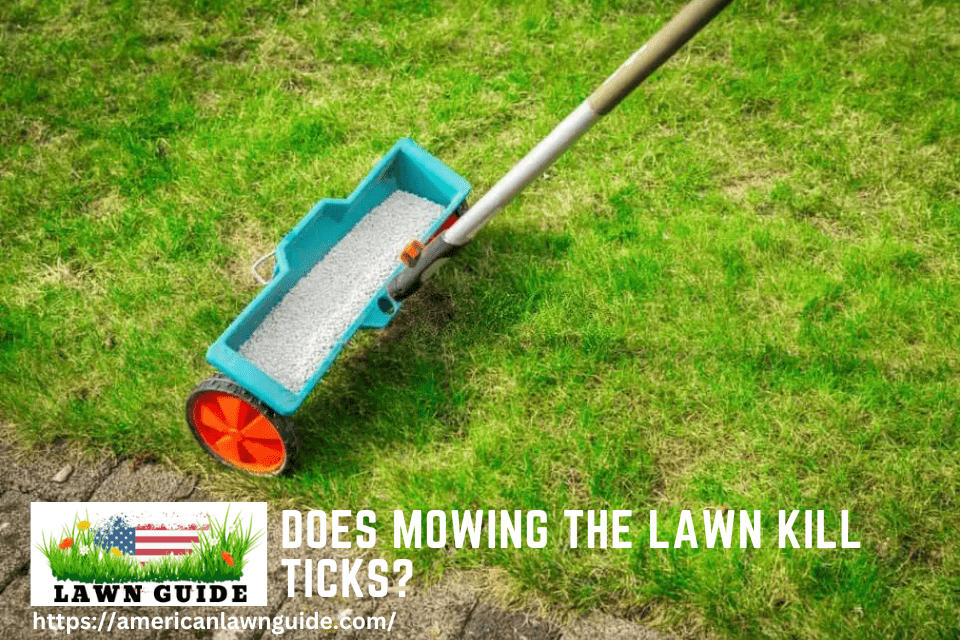Mowing the lawn does not kill ticks. Ticks can be found in tall grass and low brush, so mowing the lawn may reduce the number of ticks in an area, but it will not eliminate them completely. To protect yourself from ticks, you should avoid walking in tall grass and wear long pants and a long-sleeved shirt when you are outdoors.
You should also use insect repellent and check your body for ticks after being outdoors.
If you’re like most people, the first thing you do when you see a tick on your body is reach for a pair of tweezers. But what if we told you that there’s a better way to get rid of ticks? Mowing the lawn may seem like an odd way to kill ticks, but it’s actually quite effective.
The blades of the mower will quickly slice through the tick’s body, killing it instantly. Plus, it’s a great way to get rid of any other unwanted pests in your yard. Of course, this method won’t work if the tick is already attached to your skin.
In that case, you’ll need to carefully remove it with tweezers. But if you find a tick before it has a chance to attach itself, give mowing the lawn a try – it just might save you from a nasty bite!
How to get rid of ticks in your yard in 24 hours or less
Can Mowing the Lawn Kill Ticks?
While mowing the lawn will not kill all of the ticks in your yard, it will help to reduce their numbers. Ticks are attracted to tall grasses and weeds, so by keeping your lawn trimmed, you make it less hospitable for them. Be sure to wear long pants and a long-sleeved shirt when mowing, and check for ticks afterwards.
You can also treat your lawn with an insecticide that is designed to kill ticks.
How Can I Protect Myself from Ticks While Mowing the Lawn?
One of the best ways to protect yourself from ticks while mowing the lawn is to wear light-colored clothing. This will help you spot ticks more easily so that you can brush them off before they have a chance to bite. You should also tuck your pants into your socks and wear closed-toe shoes to further prevent ticks from getting on your skin.
When you’re done mowing, be sure to do a full tick check of your body. Pay close attention to any areas that are covered by clothing, as ticks can sometimes hitch a ride in these places and then bite you later. Use a mirror or ask someone else to help you with this task if necessary.
If you find a tick, use fine-tipped tweezers to remove it carefully without squishing it. Then clean the area with soap and water or an antiseptic wipes. You can also take some proactive measures to reduce the risk of ticks in your yard in the first place.
Keep the grass short and remove any leaf litter, woodpiles or other potential hiding spots for ticks. If possible, create a barrier between your lawn and any nearby woods or fields where ticks might live. And finally, consider using an insecticide specifically designed to kill ticks on contact; just be sure to follow all label instructions carefully when using these products.
What Should I Do If I Find a Tick on My Body After Mowing the Lawn?
If you find a tick on your body after mowing the lawn, it is important to take action immediately. There are a few things you can do to remove the tick and prevent infection. First, use fine-tipped tweezers to grasp the tick as close to the skin’s surface as possible.
Slowly and carefully pull the tick straight out from the skin. Do not twist or jerk the tick, as this can cause the mouthparts to break off and remain in the skin. If this happens, try to remove them with tweezers.
After removing the tick, cleanse the bite area with rubbing alcohol or soap and water. Apply an antibiotic ointment if available. Dispose of the tick by flushing it down a toilet or wrapping it in tape before throwing it away.
It is also important to monitor your health for signs of infection, such as fever, rash or joint pain. If you develop these symptoms within a few weeks of removing a tick, see your doctor immediately.

How Can I Prevent Ticks from Coming into My Yard in the First Place?
One of the best ways to prevent ticks from coming into your yard is to keep your lawn mowed short. Ticks like to hide in long grass, so by keeping your lawn trimmed, you’ll make it much less inviting for them. You should also clear away any leaf litter, as this can provide a perfect hiding spot for ticks.
If you have any trees or shrubs on your property, make sure they’re not touching your house or yard – ticks can drop down from branches onto unsuspecting victims below. Another good way to deter ticks is to use a tick tube. This is a small plastic tube filled with cotton that’s been treated with permethrin, an insecticide that kills ticks.
You simply place the tick tubes around the perimeter of your yard, and as small mammals like mice and chipmunks brush against the cotton, they pick up some of the permethrin and spread it around as they travel. This will help kill any ticks that come into contact with these animals before they have a chance to bite you or your family members. Finally, you can also create a tick-safe zone in your yard by using an insecticide such as bifenthrin or cyfluthrin on the ground around areas where you spend time outdoors (e.g., playgrounds, patios, decks).
Can Ticks Live in Short Grass?
Most people think that ticks can only live in long grass, but this is not the case. Ticks can actually survive in short grass as well, although they are less likely to be found there. This is because ticks need a warm and moist environment to survive, and short grass does not provide this.
Ticks are more likely to be found in areas with long grass or leaves, as these provide more shelter and moisture. If you are hiking in an area with short grass, be sure to check your body for ticks afterwards.
Conclusion
No, mowing the lawn does not kill ticks. In fact, mowing can actually help spread ticks around because they can attach themselves to your clothes or shoes. If you want to reduce the number of ticks in your yard, try using a pesticide that is specifically designed to kill them.




